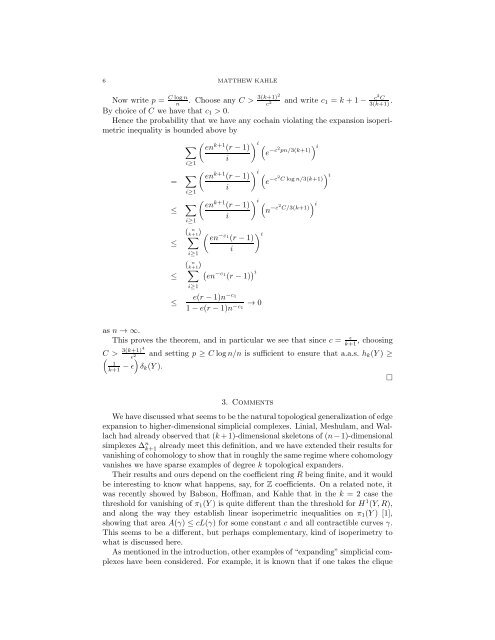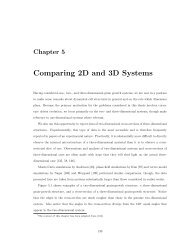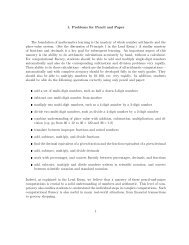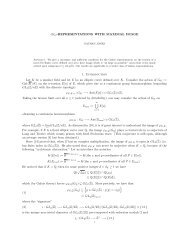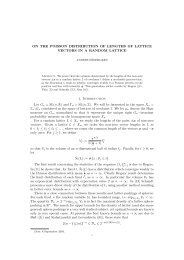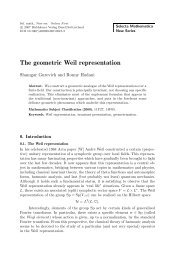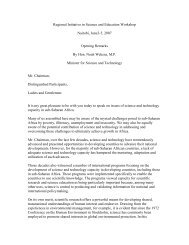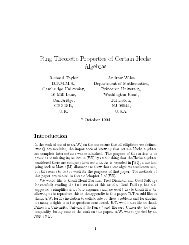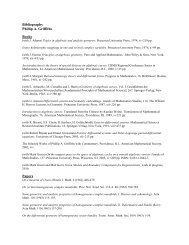TOPOLOGICAL EXPANDERS 1. Introduction Expander graphs ... - IAS
TOPOLOGICAL EXPANDERS 1. Introduction Expander graphs ... - IAS
TOPOLOGICAL EXPANDERS 1. Introduction Expander graphs ... - IAS
You also want an ePaper? Increase the reach of your titles
YUMPU automatically turns print PDFs into web optimized ePapers that Google loves.
6 MATTHEW KAHLE<br />
Now write p = C logn<br />
n<br />
. Choose any C > 3(k+1)2<br />
c 2<br />
and write c 1 = k +1− c2 C<br />
3(k+1) .<br />
By choice of C we have that c 1 > 0.<br />
Hence the probability that we have any cochain violating the expansion isoperimetric<br />
inequality is bounded above by<br />
∑<br />
( en k+1 ) i<br />
(r −1)<br />
( ) i<br />
e −c2 pn/3(k+1)<br />
i<br />
i≥1<br />
= ∑ ( en k+1 (r −1)<br />
i<br />
i≥1<br />
≤ ∑ ( en k+1 (r −1)<br />
i<br />
i≥1<br />
) i (<br />
e −c2 C logn/3(k+1) ) i<br />
) i (<br />
n −c2 C/3(k+1) ) i<br />
≤<br />
≤<br />
≤<br />
( k+1)<br />
n<br />
∑<br />
( en<br />
−c 1<br />
(r −1)<br />
i<br />
i≥1<br />
( k+1)<br />
n<br />
∑ (<br />
en<br />
−c 1<br />
(r −1) ) i<br />
i≥1<br />
) i<br />
e(r −1)n −c1<br />
1−e(r−1)n −c1 → 0<br />
as n → ∞.<br />
This proves the theorem, and in particular we see that since c = ǫ<br />
k+1 , choosing<br />
(<br />
C > 3(k+1)4<br />
ǫ<br />
and setting p ≥ Clogn/n is sufficient to ensure that a.a.s. h 2<br />
k (Y) ≥<br />
1<br />
k+1<br />
)δ −ǫ k (Y).<br />
□<br />
3. Comments<br />
Wehavediscussedwhatseemstobethenaturaltopologicalgeneralizationofedge<br />
expansion to higher-dimensional simplicial complexes. Linial, Meshulam, and Wallach<br />
had already observed that (k+1)-dimensional skeletons of (n−1)-dimensional<br />
simplexes ∆ n k+1<br />
already meet this definition, and we have extended their results for<br />
vanishingofcohomologytoshowthatinroughlythesameregimewherecohomology<br />
vanishes we have sparse examples of degree k topological expanders.<br />
Their results and ours depend on the coefficient ring R being finite, and it would<br />
be interesting to know what happens, say, for Z coefficients. On a related note, it<br />
was recently showed by Babson, Hoffman, and Kahle that in the k = 2 case the<br />
threshold for vanishing of π 1 (Y) is quite different than the threshold for H 1 (Y,R),<br />
and along the way they establish linear isoperimetric inequalities on π 1 (Y) [1],<br />
showing that area A(γ) ≤ cL(γ) for some constant c and all contractible curves γ.<br />
This seems to be a different, but perhaps complementary, kind of isoperimetry to<br />
what is discussed here.<br />
As mentionedinthe introduction, otherexamplesof“expanding”simplicialcomplexes<br />
have been considered. For example, it is known that if one takes the clique


